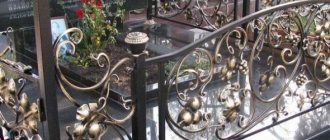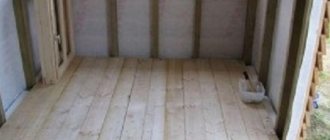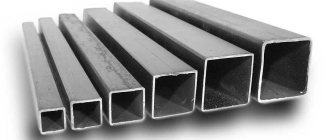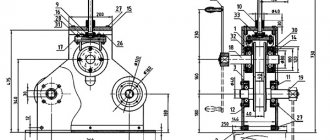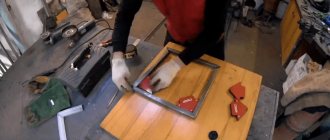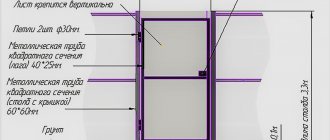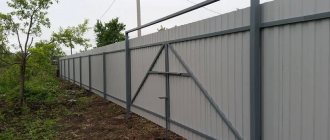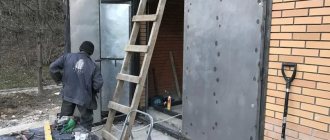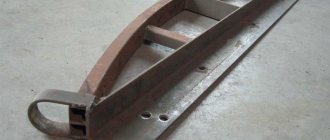A grave fence is a decorative structure that is made as a decoration for a memorial. With its help, the space around the burial is separated, and visually all components of the monument and tombstone become one.
Many companies that provide funeral services offer many different designs, and the most popular are fences made from profile pipes.
Fencing scheme 2x3 m
Types of grave fences
Many people think about installing a fence on the grave of a loved one with their own hands. After all, this is not only a good opportunity to save on the services of specialists, but also a unique way to express the last tribute to the deceased, to make a beautiful and unique fence. Before installing a fence in a cemetery, you need to ask permission from the administration. You should also keep in mind the size of the plot of land and not go beyond it.
- metal - welded, forged;
- concrete;
- wooden;
- made of stone - granite, marble.
Not all of them can be easily installed independently; working with the same marble fences will require too much special equipment and skills that not everyone has. But people who are at least at a basic level familiar with welding and construction can easily install a fence on a grave with their own hands from more affordable materials - concrete, wood or metal.
Wooden fence
Advantages of wood fencing:
- their light weight;
- availability of material;
- relative ease of working with them;
- beautiful appearance;
- the opportunity to show imagination and create unusual shapes and decorative elements.
The main disadvantages are fragility and fragility - a wooden fence in a cemetery is extremely susceptible to natural conditions, especially sun and rain, and it will have to be cleaned of mold and repainted annually.
In order for a wood fence to last longer, you need to use the right material. After making the drawings and cutting out the necessary blanks, all boards must be well dried, sanded and polished. Then impregnation is carried out several times and, after complete drying, the bars are covered with moisture-resistant paint. At the end, the finished structure is assembled using bolts or self-tapping screws.
Concrete grave fence
Features of concrete barriers:
- low cost;
- they go well with monuments and tombstones, since they are also often made of concrete;
- since they cannot be painted, the color of the fence will always be standard;
- durability and strength depend on the quality and type of cement. But under the influence of destructive weather conditions, concrete products on average last no more than 20 years.
You can make concrete blocks yourself or install ready-made ones purchased in advance. In the first case, molds are first made from boards into which the solution is poured. You should not make the blocks very large - since concrete is a heavy material, it will be inconvenient to work with them. For greater strength, reinforcement is installed in the molds. After the blocks harden, they are polished, primed and impregnated. And only then the finished blocks are installed on the grave.
Metal fencing
Aluminum, copper or iron fences are one of the most popular types of fences in the cemetery. And there are reasons for this:
- they look elegant and respectable;
- do not require constant care;
- high wear resistance, immunity to temperature, unlike the same concrete fences. Therefore, they can be used in all weather conditions;
- relative cheapness of the material;
- You can independently weld fences of any shape and paint them in any color.
The most beautiful of metal fences are forged ones; they can have floral, abstract, or geometric patterns. But their manufacture requires high blacksmithing skill. You can order a specialist to perform some elements, and then install them yourself. But a more economical way would be to weld the fence yourself from a profile pipe or fittings. It is worth considering that all welding work on metal is done in advance, at home or in a workshop, because in the cemetery there is no place to connect electrical equipment, and only ready-made sections are installed there.
After creating the necessary measurements and sketches, the pipes (most often round or square are used) are cut and welded. All sections are carefully treated with anti-corrosion primer and painted with acrylic paint. For some elements, you can use silver or gold paint with a patina effect; this will give a noble and solid look to the grave complex.
Front garden near the fence
Fencing for the front garden and flower beds can be made of the same materials: concrete, wood, metal. But the height is often less than that of a fence for a grave made of corrugated pipe. These fences are made by hand. For this, improvised materials are often used: brick, wood, plastic - this way you can delimit the space. It is not practical to use reinforced structures, since the front garden in the cemetery area is located inside the perimeter of the fence.
You should not prepare a reliable foundation for the front garden, since this is a lightweight structure. It is enough to install the sections as deep as possible so that they are not carried away in bad weather.
Decoration with artificial flowers
Very few artificial flowers are placed on the grave. One beautiful bouquet or wreath is enough. The shade of the buds depends on the gender and age of the deceased.
The graves of children and young people are covered with white lilies or chrysanthemums. It is customary to decorate women's graves with red roses; men's graves do not need additional decorations.
Decorating a grave with artificial flowers
Artificial bouquets fade in the sun and need to be changed frequently.
To simplify the care of the grave, it is customary to replace the Orthodox cross with a monument, cover the grave mound with granite or marble slabs, fill the area around them with crushed stone or marble chips, and plant flower beds.
A fence is installed around the grave, and a bench and table are placed inside. Even if relatives do not come to the cemetery for several years in a row, the appearance of the burial will not change.
Principles and methods of landscaping a cemetery
Flowers, grass and trees are planted next to the graves. Sometimes tombstones are decorated with artificial compositions
It is important to adhere to the general color scheme without ruining the ensemble
An example of landscaping at a grave site
Decoration with flowers and grass
It is easy to arrange a lawn or a large flower garden around the grave. This reduces the cost of its arrangement, but increases the time spent on cleaning. Any flowers can be chosen, but most often these are perennials:
- tulips;
- daffodils;
- peonies;
- irises.
Unpretentious immortelle plants and cornflowers creeping along the ground will take root well in the cemetery. For landscaping, areas are planted with periwinkle. The plant blooms with beautiful blue and lilac flowers, the leaves are oblong, covering the burial with a green carpet.
Artificial flowers
Artificial bouquets can also be anything. It is better to choose 1-2 beautiful wreaths or create a composition of 6-10 flowers of the same size and color. There is no need to take care of artificial materials - this is a definite plus. But they quickly deteriorate and fade under the influence of moisture and sun, which is reflected in the design of the site. About once a year old bouquets have to be replaced with new ones.
Making a fence from corrugated sheets
- Profiled sheet. For arranging a fence, the best materials are grades C-8 and C-10, as well as C-20 and C-21.
- Fastening elements. We buy dowels 30-40 mm long.
- A can of car paint.
| Brand | Overall sheet width, mm | Useful sheet width, mm | Profile height, mm | Metal thickness, mm |
| S-8 | 1200 | 1150 | 8 | 0,4-0,8 |
| S-10 | 1155 | 1130 | 10 | 0,4-0,7 |
| S-15 | 1200 | 1150 | 15 | 0,4-0,8 |
| S-18 | 1150 | 1100 | 18 | 0,4-0,8 |
| S-20 | 1150 | 1100 | 20 | 0,4-0,8 |
| S-21 | 1051 | 1000 | 21 | 0,4-0,8 |
| S-44 | 1047 | 1000 | 44 | 0,5-0,8 |
| MP-18 | 1150 | 1100 | 18 | 0,4-0,8 |
| MP-20 | 1150 | 1100 | 18 | 0,4-0,8 |
| MP-35 | 1076 | 1035 | 35 | 0,5-1 |
| N-60 | 902 | 845 | 60 | 0,5-1 |
| N-75 | 800 | 750 | 75 | 0,7-1,2 |
| N-114 | 646 | 600 | 114 | 0,7-1,2 |
| NS-35 | 1100 | 1035 | 35 | 0,5-1 |
| NS-44 | 1050 | 1000 | 20 | 0,4-0,8 |
Installation instructions
The supports and crossbars are already installed. Next we do the following.
We fix the profiled sheets with an overlap of 1 wave. To fasten the sheets we use self-tapping screws. We screw in the fasteners in increments of 500 mm. During the installation process, scratches will inevitably remain on the sheets. They can be quickly and easily hidden with spray paint. You can also mask it with regular paint to match the color of the sheets, but using a spray can is more convenient.
Fastening profiled sheets
Fastening the corrugated sheet
Fence made of corrugated sheets
What size can a grave fence be?
The dimensions of the fence are determined by the parameters of the grave mound and the permissible deviations from it. But some plots in the cemetery are larger than others, accommodating just one grave, while others are 2 meters wide and 3 meters long. This is exactly the size of a standard fence.
Most likely, a large area is legally allocated for another burial expected in the future (the daughter wants to bury her father next to her mother, the children plan to be buried next to their parents).
You cannot decide on your own what size the fence will be. Even if there is a lot of space around the grave, you should notify the cemetery administration and obtain permission to carry out installation work.
Fence drawing example
Expert commentary
Sergey Sivokonev
Head of the improvement department at the Northern Cemetery, Rostov-on-Don
When manufacturing metal structures, you need to remember the properties of iron. Large-sized products (and 2- and 3-meter ones are just such ones) can lead to trouble. To prevent the metal from warping, you must first weld the elements that will be located on the inside of the pipe (when viewed relative to the entire structure). Before painting, the product must be degreased. Another nuance is cleaning the welds. This will make it possible to better prepare such areas for finishing work. A wire brush is used for cleaning, but it must be used carefully to avoid deep scratches. Such defects can negatively affect the decorative qualities of the entire product.
Examples of beautiful ready-made solutions
Let's look at examples of design solutions for tombstone fences in a cemetery. Which option to choose is up to you to decide; each has certain advantages, although it is not without its disadvantages.
Forged
For forged fences, any shape can be used. Such structures are made from twigs; they are capable of forming elaborate weaves. Roses, arrowheads, vines, leaves, and metal plates also become masterful decorations. A wrought-iron fence is not cheap, but it looks dignified and sophisticated, as the photograph convinces.
Forged fence
From a profile pipe
A product made from a profile pipe is a common way to make a cemetery fence. Metal profiles owe their popularity to their ease of installation and relative cheapness. After welding, profile pipes form a simple geometric pattern. After installation, they are painted in any color, sometimes using powder dye. The products are hollow inside, so the structure is lightweight. Its advantages are as follows:
- the fence is durable because it has a rigid frame;
- not afraid of mechanical damage;
- the cost of the product is not high;
- It’s easy to build a structure; all you need is a welding machine.
Fence made of profile pipe
Fences made of natural stone
These structures are also called plinths because they look like a low fence, for which granite is usually used. Visually, such fences look nicer than metal ones and are easier to care for. This product will never rust, does not need to be painted, and will not fade under sunlight. Fencing is often used as a memorial complex. A granite monument looks noble when the area around it is paved with similar tiles, completed by a base made of the same material. To complement the ensemble, they also order a corner granite ball separately, securing it around the perimeter, as in the photo.
Granite fence
Such fences are mounted on top of a concrete base, since without it they will sag. The products have different configurations. They are resistant to weather conditions, such structures are reliable and durable.
Marble or granite structures are expensive, but the investment is justified. The fences look solemn, they are harmonious and noble.
Chains
Using a chain as a fence involves a combined version of the fence. Stone or metal posts made of stainless steel are installed around the perimeter, and a chain is pulled between them, providing a slight sag. Granite or marble can be used as material for pillars.
Chain fence
Concrete
Such fences are relatively inexpensive, but their service life is short (maximum 15 years). The material is not resistant to moisture and low temperatures; only standard sizes are used to make the structure. The color range of the products is meager, although they are often decorated with stonework.
Mesh fences
Occasionally, fences are made using metal mesh. It is stretched between dug-in pillars, after which it becomes a hedge along which climbing plants weave. For durability, galvanized material is recommended. This kind of fencing has a low cost, but the metal in the soft mesh is short-lived.
What are grave fences made of?
Fences for installation around graves are most often made of metal, wood or wrought iron. Much less often, a fence around a burial site is installed from natural stone, concrete or plastic (products made from concrete and plastic are in many cases short-lived).
Manufacturing of forged fences
Made by hand from forged metal, which increases durability and cost. The final price consists of such characteristics as dimensions and the number of complex elements - patterns. If the drawing seems complex to the master (presence of small details), then he will ask for 1.5-2 times more than usual. The simplest fencing will cost approximately 6-12 thousand rubles. The cost of a product with numerous unusually shaped elements is 35-70 thousand rubles.
They combine beautifully with monuments made of granite or marble, as they have an elegant design and do not weigh down the space.
Making a concrete fence
It is inexpensive, compared to the production of a wrought-iron fence, to place concrete formwork around the perimeter of the grave, painting it or laying it with facing tiles. The approximate height of the section is 25-30 cm. It is easy to step over, but the concrete fence copes with its task of marking the location of the grave. For installation you will have to make a strip foundation.
Making a metal fence
Copper, steel or aluminum are used to produce metal fences. Steel fences (made of profile pipes or metal corners and rods) are strong and durable, manufacturing and installation work is simple. To make a good fence with your own hands:
- the craftsmen are called to the cemetery to take the necessary measurements and draw up a project or drawing;
- after determining the material and the exact size of the work to be done, an estimate is made;
- they assemble individual parts in the workshop (there is no electricity in the cemetery, so welding and other tools are used only if they are powered by an additional power source).
The price of the fence is 5-12 thousand rubles. It depends on the presence of forged elements, the amount of work and the size of the fence.
Granite fence
Wooden fencing
The simplest and most short-lived option. You can make it yourself. To do this, into the ground around the grave mound along its perimeter:
- they dig in wooden posts, or even better - concrete pipes with a diameter of 15-20 cm (the pipe is buried in such a way that its upper part is flush with the ground);
- A wooden post pre-lubricated with grease (from moisture) is placed inside and fixed with cement mortar;
- Several poles are screwed to the posts with ordinary wire or nailed (depending on the height), and tree branches cut into pieces 45-70 cm long are attached to them.
Installation of wooden fencing can also be ordered. In this case, timber, slats and boards, decorated according to the customer’s requirements, are used. The wood is often fired to increase its strength. The price of a fence for a grave, installed with your own hands, is determined by the quality of the wood. Fences made from oak boards are more expensive than those made from pine. The average price is 10-15 thousand rubles.
Wooden fencing requires constant maintenance. Every year it needs to be inspected, repainted, and sometimes repaired. Such a fence is easy to disassemble and carry away, so it is better not to install it if the grave is located at the far end of the cemetery, out of sight of the caretakers.
Wooden fence
Fences made of natural stone
Most often made of granite or marble. They allow you to highlight the place where the grave is located, making the area neat and landscaped. The cost and installation time depend on the material, size, and special requirements for the installation method (on or without a foundation). Thus, the price of a granite fence ranges between 25 and 160 thousand rubles. This price is also explained by the durability of the stone.
Plastic fencing
They are manufactured quickly and can be installed independently. The average price is 2-3 thousand rubles per linear meter. The standard fence height is 70 cm. The service life depends on weather conditions and the quality of installation. Light fences need to be securely fixed to the ground to prevent them from being blown away in strong winds.
What are the benefits of fencing made from profile pipes?
Metal fences are often made from profile pipes. It's comfortable:
- the pipe can be dug into the ground, it does not rot, and if properly processed, it does not rust, so there is no need for a foundation;
- metal is cheaper than natural stone and even wood;
- such a design is almost indestructible, the pipes can only be cut down, even a bent product can be restored;
- installation does not take much time, you can do it yourself.
Features of the production of fences made from profile pipes include:
- cutting (pipes are made to a certain length, most often several times the height of the fence);
- assembly is carried out at the grave, but chains and other decorative elements are attached in a warehouse or workshop.
The metal fence is not easy to remove or not to be noticed when the car turns around (if the grave is located near the road, it can be trampled on or even made part of the roadway).
Grave fences - main types, types and care
To make the burial site look well-groomed, it is fenced off with a special fence. You can make and install it with the help of specialists or with your own hands.
Before deciding which type of fence to choose, you need to carefully consider all the options and compare prices for products from different providers.
Purpose
A fence for a burial site is a ritual product with a large number of tasks and functions.
Such a fence is an integral part of the entire burial complex. The main purpose of the fence is to protect against intrusion by unauthorized persons. In addition, using a fence you can separate the grave from the rest of the cemetery.
The aesthetic purpose of the fence is to create a well-groomed and beautiful appearance of the burial. It gives the grave an individual look and nobility that is unlike all others. In addition, with the help of a fence, it is much easier to maintain cleanliness and order at the burial site. In particular, this will protect the grave from the spread of weeds.
What are the varieties?
There are many types of grave fences. All of them have differences among themselves in terms of stability and service life, appearance and production features.
It is customary to distinguish the following categories of barriers:
- Stone fence.
- Concrete.
- Forged or welded metal.
Concrete
It is customary to install concrete fencing on relatively small memorial complexes. This option has a more affordable price. Such fences have a standard shape and color and are made of the same type of cast elements. The product has some disadvantages.
- Low wear resistance.
- Short service life.
- Monotonous standard design.
Typically, such products are made from blocks of gray concrete with an average height of about half a meter. Brickwork or flowers can be used as a type of pattern.
Stone products
These types of fences are made of natural stone - granite or marble. They are distinguished by much higher prices, durability and noble design.
Metal fences
Due to the optimal ratio of quality and cost, this fencing option is the most in demand and popular. In addition to excellent external data, such products are durable and resistant to climatic influences. And they are very easy to care for.
The forged variety of metal products is more difficult to produce. This work is performed by specially trained blacksmiths. Individual metal rods are cut into pieces of a certain length and welded into a solid structure. If necessary, they can be processed in a special way to give them a noble golden-bronze hue.
The cost of such products directly depends on their complexity and sophistication of appearance.
Fence installation
You can do the installation yourself or hire professionals for this purpose. The main task of installation is to install the fence very firmly and efficiently.
This can be done in different ways:
- Installation in a plinth made of various materials. If desired, it can be finished with marble or granite tiles.
- Installation of supporting structures in concrete pillars. To do this, holes up to a meter deep are dug and concrete solution is poured into them. Load-bearing structural elements are installed in concrete.
- The easiest and most reliable way is to dig into the ground around the entire perimeter.
Maintenance and repair
In order for the grave to always have a well-groomed appearance, it is necessary to constantly monitor its condition. This will preserve the noble appearance of the burial and extend the service life of the tombstones and fences.
It is very important to constantly clean the fence from dirt and debris, tint it and repair it. Cleaning is carried out using water and suitable detergents
Wrought iron fences need to be cleaned once a year and also need to be repainted. Paint must be used that is resistant to climatic conditions. In addition, it is advisable to coat a metal fence with special compounds to protect against corrosion.
Concrete and stone barriers require more complex maintenance. If cracks or chips form, they must be treated with a special compound.
Types of fencing made from profile pipes
A metal profile is a cheap and fairly flexible material. You can make fences of any size and shape from them. For this purpose, pipes with a square or rectangular cross-section are used. The strength of the frame and the number of decorative parts that can be attached to it depend on the thickness and height of the pipe. Most often, customers are offered the following type of fencing:
- a fence made of pipes of different heights and thicknesses (separate sections are intended for installing racks, attaching decor and framing, cut them according to the sample);
- the posts, frame and decorative elements are made of material of the same shape and size, the differences lie in the location, the patterns are made from pipes of the same thickness as the base:
- simple design, decorated with forged parts.
When using pipes of different sizes, they try to maintain precise geometric shapes. If the patterns are made only from the profile (diamonds, squares, tetrahedrons), the design is simplified, the main thing is not to overdo it with the number of parts. The presence of forged patterns adds originality to the fence.
Types of landscaping of graves: designs of graves in a cemetery
The grave can be improved by using the following to create a beautiful design:
- Concrete paving slabs. You don’t need a lot of money to decorate a grave in a cemetery with tiles. Concrete is a cheap material, grass does not grow through it, and sinkholes are almost impossible. But the slabs are very heavy; transporting and installing them will require a small conveyor or several strong men who could lift and place the monolith as needed.
- Granite slabs. Expensive granite slabs are built to last. They are beautiful, do not allow moisture to pass through and prevent grass from growing, and are suitable for graves of any size. The only negative is the price and speed of installation.
- Sprinkling the ground around the grave with crushed stone or marble chips. Inexpensive material, the scope of which in construction is almost unlimited. But if you lay it in compliance with all technological features, it will last for decades.
- Laying the area around the grave with artificial grass, growing a living lawn. The grave can be lined with artificial grass or planted with live grass, which requires regular mowing and watering, which is not always convenient. Artificial grass is cheap and practical and can cover an area of any size in a short time.
A wooden or forged fence is installed around the burial, and a table and bench are placed inside. To place fresh and artificial flowers, a marble, granite, ceramic or metal vase is attached to the gravestone.
Tile and crushed stone for the grave
The surface around the grave can be covered with paving slabs. The material is expensive, difficult to use, and installation takes a long time. But if 1-2 tiles are destroyed, they can easily be replaced with new ones.
Requirements for the arrangement of burials
The appearance of the burial depends not only on the wishes of the relatives of the deceased, but also on the requirements of the cemetery administration. As a rule, a plot measuring 1.8 by 2 meters is allocated for one burial. If in the future they plan to bury another relative (husband and wife are often buried together), an area of 2 by 2.5 meters will be allocated. In densely populated regions, the allocated plot of land may be smaller. You should also know:
- Are there restrictions on the height of the monument (the maximum height of the monument in some cemeteries is 2 meters);
- the opinion of neighbors in the area (perhaps the erected fence will become an obstacle to access to the burial site, for example, for a person in a wheelchair).
When arranging a funeral, the feelings of believers are taken into account. Thus, you cannot use satanic symbols, ugly figures and images for decoration.
Step-by-step making of a fence with your own hands
You can make a fence for burial in a cemetery yourself without much difficulty; profile material is taken as a basis. When developing the design of the structure, consider the following factors:
- column, which is the basis of the frame. The product will be made of a pipe with a square cross-section. Material dimensions can vary from 2.5 to 4.4 cm;
- the basis of the section is made up of pipes with a parameter of 2 or 2.5 cm;
- the drawings take into account all the decorative elements of the fences in the cemetery;
- think over the design of the gate so that you can enter the territory without any problems.
How to install a fence in a cemetery yourself
Welding and assembling the fence is half the battle, because you still need to install it correctly. If possible, it is best to carry out installation work in the summer, and not in the winter, when frozen soil will only add complexity to the process. Also, before installing the fence, the area is cleaned.
There are the following types of installation of grave fences:
- Installation directly into the ground. Support pillars are dug into pre-dug holes and sprinkled with crushed stone or any other similar material. Needless to say, with this design you can only install a very light fence. Plus, it is not particularly durable and will “crawl” after the first rainstorm. Suitable for temporary barriers only.
- Most often, a fence is installed by filling the support pillars with concrete. This is a fairly inexpensive and not the most complicated method. First, you need to dig holes around the perimeter, carefully following the measurements, then fill it with concrete mortar prepared on site. This technique is well suited for metal barriers and will allow them to last for many years.
- Installation in a concrete or granite base. The advantages of this method are that it is suitable for the heaviest fences and has an aesthetic appearance. It can be lined with stone to match the color and texture of the fence or monument itself. The downside is that it is difficult to make such a foundation yourself using available materials, so you will have to order it.
There is another rather exotic, but recently gaining popularity, type of grave fence - a hedge. The good thing about it is that it can be done by people even without any construction skills. And the green fence looks very beautiful and original. A good option would be to choose evergreen plants that are unpretentious to outdoor conditions, such as juniper or blackthorn. The downside is that they will have to be looked after annually and returned to their original shape.
Drawings and examples
When making a sketch of a pipe fence, take into account the following:
- the base is made of columns with a square cross-section measuring 2.5 by 2.5 cm, 3 by 3 cm or 4 by 4 cm;
- For individual sections, pipes measuring 2 by 2 cm and 2.5 by 2.5 cm are suitable.
If you are putting a fence on a grave with your own hands, it is better to have the drawings and dimensions determined by a specialist.
When you decide to weld a fence with a height of 50-70 cm, you need to lay a gate on the diagram; not everyone remembers this. Instead, sometimes they make a chain with slack, but the first option looks better. When installing a fence made of stone or concrete, no gates are made.
Pipes:
- cut into pieces 1 m long. This is slightly higher than the size of ordinary fences around graves, but take into account that the resulting metal pins will also have to be buried in the ground;
- in the upper part, plates (size 10 by 10 cm) are attached to the ends.
If the customer has already dealt with profile pipes, he can easily install the fence himself. When installing a fence made of stone or concrete, there is also no need for special knowledge, but not everyone is able to dig a foundation correctly and lay facing tiles. It is better to negotiate with a company that installs monuments.
To increase the strength of a metal or wooden structure, it is filled with concrete. In the drawing of the fence, you need to indicate the location of the holes for the posts, their width and depth (usually pipes or supports are dug in to a depth of 40 cm, the foundation is also made shallow).
You can make a rough drawing yourself, but it is better to order the fence from the same place where the monument is made. In this case, you can already understand from the first sketches whether these structures are suitable for each other, whether they make it heavier, turning the burial into a gloomy memorial.
Installation methods
Depending on the installation method, the installation is carried out as follows:
- It can be installed by simply digging in pillars and light enclosing structures - the pits are reinforced with bricks and large crushed stone. This method is simple and easy. But unreliable - it will be easy to steal it by simply pulling it out. The depth to which the pillars are immersed is not always great, so after a few months or years it will have to be installed again.
- By concreting the pillars - this method is more reliable, but a lot of effort must be put in during the installation process. The pillars are being driven into the hole, then the space is filled with concrete. But the difficulty is that the cement mortar must be prepared on the territory of the churchyard, and this is not always convenient.
- Installation method on a strip foundation. The base is polished and varnished, tiled.
Depending on what metal the fence is made of, the master chooses the installation method. If it is, for example, wooden, light, you can simply install it in the ground, if it is stone, the craftsmen talk about the need to prepare the foundation for the fence.
Metal models
It is unknown where the tradition of putting up a fence and enclosing the burial site came from, but it is the metal one that is in greatest demand. Characterized by a high degree of wear resistance.
Models are available to everyone at a price. But that's not all:
- looks solid, elegant - any patterns can be cast from metal;
- there is no need for constant maintenance, cleaning, painting, especially if it is galvanized steel;
- availability of material;
- can be given different shapes and patterns;
- durable, reliable to atmospheric phenomena - snow and rain, sun and temperature fluctuations;
- the height can be any, the thickness of the pillars, sections.
Metal fence
When creating, a profile pipe and metal corners and rods are used. The mesh is often applicable as a separate element of fencing - a lot depends on the sketch.
Forged models
This is the most beautiful fence, having the most different designs. They are made using floral and abstract, geometric patterns. Reliability, durability and aesthetics of the design of the last burial place of the deceased are important.
Forged fences, like metal models, do not require special care; they are resistant to temperature changes and precipitation. But their disadvantage is the high cost of work.
Pillar and chain models
This fencing is more likely classified as decorative - they are made of poles installed in the ground and chains made of metal or plastic. Fences with metal chains are in considerable demand.
They are characterized by the following:
- durable, reliable;
- easy to install and daily care;
- With regular cleaning and painting, they will last a long time.
Wooden models
Example of a wooden fence
These models are typical:
- lightweight, easy to install, and easy to maintain;
- the material is available to every buyer;
- the size varies greatly;
- presentable appearance;
But, the truth is that the disadvantages of this type of model include fragility and lack of practicality - wood is highly susceptible to temperature changes and precipitation. Therefore, they must be regularly cleaned of dirt and mold, treated with a primer, and tinted.
Grave concrete barriers
How to choose and install a reliable fence in a cemetery? Opt for a concrete fence. And all because of these advantages:
- affordable price;
- the latter harmoniously combine with concrete tombstones;
- durable, strong - can last more than 20 years;
- They don’t paint, so the fence colors are standard.
Although some may attribute the last point to disadvantages, everything here is purely individual.
Concrete blocks can be made independently, by pouring forms and subsequent installation, or you can install ready-made, factory-made fencing sections.
They can be given any shape. But here you will have to tinker a lot. The second option is more practical. Thanks to the use of reinforcement for reinforcement.
“Question-answer” section
How do Muslims arrange their graves?
Expert opinion
Klochkov Andrey
Employee of the improvement department of the municipal unitary enterprise "Clean City"
The main requirement for the design of Muslim plots is modesty. Excesses are not welcome when creating a tombstone; the shape and appearance - everything should be simple. Often a simple rectangular slab is installed. Initially, it was forbidden to even go to cemeteries, until the Prophet Mohammed himself lifted the ban. But later the rules were somewhat abolished. Gradually, strict restrictions regarding the arrangement of graves were relaxed. If previously it was customary to leave the simplest identification marks, over time new traditions were formed. This is due to the fact that Islam became more popular; other peoples who previously adhered to pagan beliefs also accepted this religion. As a result, a mixture of cultures occurred, and some customs became part of Islam.
Are there ready-made fences for sale? Collapsible?
Expert opinion
Klochkov Andrey
Employee of the improvement department of the municipal unitary enterprise "Clean City"
We offer ready-made parts of the structure, as well as small inserts for creating a fence on your own. If you have never had to do such work before, purchase a collapsible version. Individual sections are connected by welding or special fasteners, which depends on the type of material. Moreover, the first method mentioned has many advantages. If possible, you should choose this one. The only drawback is the lack of skills in working with a welding machine.
